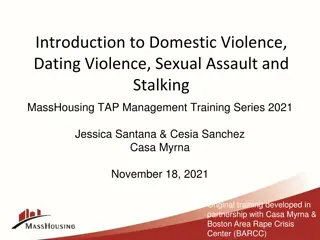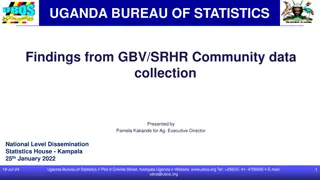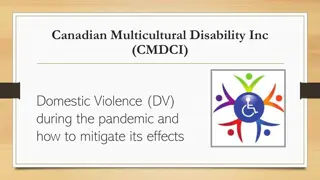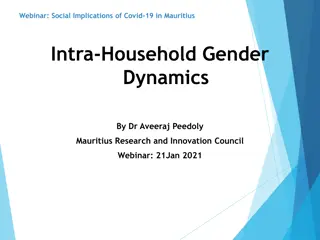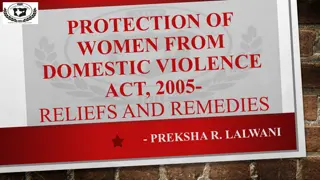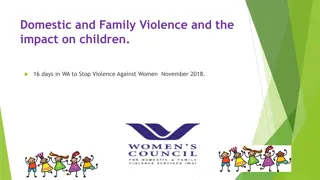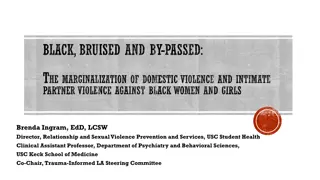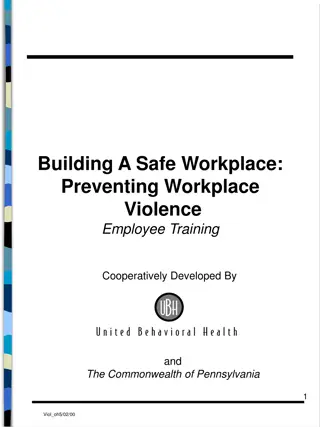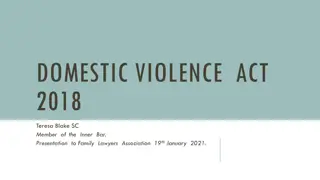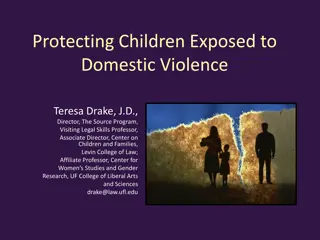Patterns of Domestic Violence: Insights and Trends
Domestic violence is a complex issue with various patterns and dynamics. Research has shown a correlation between social-legal power and rates of violence, indicating a need for societal changes. Understanding different types and prevalence rates can help in creating more effective intervention strategies to address this pervasive problem.
Download Presentation

Please find below an Image/Link to download the presentation.
The content on the website is provided AS IS for your information and personal use only. It may not be sold, licensed, or shared on other websites without obtaining consent from the author.If you encounter any issues during the download, it is possible that the publisher has removed the file from their server.
You are allowed to download the files provided on this website for personal or commercial use, subject to the condition that they are used lawfully. All files are the property of their respective owners.
The content on the website is provided AS IS for your information and personal use only. It may not be sold, licensed, or shared on other websites without obtaining consent from the author.
E N D
Presentation Transcript
September 30 2021 Global Initiative for Boys and Men
Google : Images: domestic violence How frequently does this happen? E.g. for 100,000 couples how many have this kind of wife battering abuse pattern? Eg. Male uses severe violence, repeatedly against a non-violent female victim 2
Domestic violence is committed mainly by males against non-violent females Gender paradigm Done to preserve patriarchy social arrangement with men at apex
John Archer (2006): Cross cultural rates of domestic violence. As women s social-legal power increases in nations 1) domestic violence against women decreases 2) domestic violence by women increases Personality and Social Psychology Review 2006, 10 (2), 133 -153
Patterns of Domestic Violence: So what do domestic violence types look like in the USA? Jan Stets and Murray Straus (1992) UNH- reported 1985 U.S. national survey data Looked at various patterns of domestic violence Source: Journal of Family Violence 1992, 4, (1), 37 -54
METHOD lit searched Psychlit to mid 1997 using marital or dating , aggression or violence took only studies that had data on both sexes (426 studies) calculated d a measure of effect size Generated combined sample of 65,000+ John Archer d is expressed as a fraction of a standard deviation difference between distributions J. Archer (2000) Sex differences in aggression between heterosexual partners: A meta- analytic review. Psychological Bulletin, 2000, 126 (5), 651-680 7
Meta analytic study of sex differences in Meta analytic study of sex differences in aggression (Archer aggression (Archer Pych Pych. Bull. 2000) . Bull. 2000) N Men N Women Effect Size Violence 30,434 34,053 -0.05* Injury 7,011 7,531 0.15 Medical Treatment 4,936 6,323 0.08 * women slightly more likely to be violent and injured 8
Ann Coker et al 2002 Re analysed data from the National Violence Against Women Survey Male respondents = 7,122 Female respondents = 6,790 Psychological Consequences Assessed associations between physical, sexual and psychological abuse victimization and consequent physical and psychological effects Psychological and physical victimization produced similar effects in both genders depression, substance use, chronic physical illness, chronic mental illness Coker AL, Davis KE, Arias I, et al. Physical and mental health effects of intimate partner violence for men and women. American Journal of Preventive Medicine. 2002/11 2002;23(4):260-268. 9
Past Year Incidence Rates by Demographic Demographic category No domestic violence Any IPV Severe IPV source White middle class 97% 3% 1% Cazaneave & Straus 1992 p 330 white working class 94% 6% 2% Black middle class 93% 7% 2.3% Black working class 86% 14% 4% Hispanic all classes 83% 17% 7% Straus & Smith 1992 p 351 All categories 84% 16% 5.3% 10
% of IPV Reports1 Male2 Female3 Bilateral Stets & Straus, 1989 National FV Survey (n=5,242) Married 15% 15.6% 35.6% 38.8% Cohabiting 35% 14.3% 34.9% 45.2% Whittaker, et al. 2007 National Longitudinal Study on Adolescent (18-28) Health (n=11,370) 24% 14.8% 35.6% 49.7% Williams & Frieze, 2005 National Comorbidity Study (n=3,519) 18.4% 21.6% 28.7% 49% Caetano, et al., 2008 National Survey of Couples (n=1,635) 13% 14.6% 25.6% 59.7% Morse, 1995 National Youth Survey 1992 (n=1,340) 32.4% 16% 30% 47.4% 1. The percentage of IPV reports from the total population examined in the survey. 2 Males uses more severe acts of violence (eg. male minor, female none; male severe, female none; male severe, female minor) for all who report IPV. 3 Females uses more severe acts of violence (eg. female minor, male none; female severe, male none; female severe, male minor) for all who report IPV. 11
Sarah Desmarais: Partner Abuse State of Knowledge (PASK) Project Desmarais et al 2012- combined data from 750 studies of IPV incidence reduced to 249 studies with most complete information 86% of studies done in US Sample sizes ranged from N of 42 to N of 135,000 In general, past year rates are considered most reliable Lifetime rates suffer from memory issues Desmarais, S. et al (2012) Prevalence of physical victimization in intimate relationships. Part 1: Rates of male and female victimization. Partner Abuse, 2012, 3 (2), 140-169. 12
Desmarais: Partner Abuse State of Knowledge (PASK) Project- Victimization by IPV Victimization rates obtained from 249 research articles reporting incidence 13
Desmarais: PASK IPV Perpetration Rates Perpetration rates by gender 14
victimization perpetration Male 18% 18% female 13% 23% Male rates reported by males, female rates reported by females Past Year- Large Survey studies 15
Google : Images: domestic violence How frequently does stereotypical wife battering happen? Eg. Male uses repeated severe violence, against a non-violent female victim Males use more severe violence than females in 15.6 % to 21.6% of all reported IPV in surveys BUT only 1/3 of this is severe violence (i.e. injurious) based on survey reports So severe violence would be about 7% (e.g. 21.6% X .33) BUT only about 1/3 repeat so 2.5 % of all IPV is repeat wife battering (e.g. 7% X .33) BUT only 15-35% of everyone surveyed reports any IPV So population estimate of wife battering would be 2.5% of 35% = .009 % (9 in 100,000) 16
Deborah Capaldi et al (2009)-followed community sample longitudinally from age 17 to 27 Recorded psychological issues and domestic violence Capaldi: Oregon Youth Survey Assessed mutuality of IPV- who initiated, escalated? etc? Also noted police arrests ( n =310) Modal pattern: mutual abuse (44% of men, 39% of women had used severe abuse) in arrested group On one occasion, level of IPV raised above norm for couple -> police called, man arrested 85% of the time On composite scores of physical/psychological abuse men arrested were less violent than their partners
"the men arrested for IPV were involved in relationships with high levels of physical and psychological aggression by both partners. The view that those involved in official IPV incidents would be couples predominantly characterized by one sided male-to-female aggression or "patriarchal'" or "intimate terrorism" (Johnson 1995, Johnson and Leone 2005) was therefore not supported" (op. cit. p 516). Capaldi et al ( 2009) Capaldi, D. et al, Official incidents of domestic violence: Types, injury, and associations with nonofficial couple aggression. Violence and Victims, 2009, 24, 4, 502 -519 18
Studied 302 men who called dv hotline for men (New Hampshire) Denise Hines & Jan Brown 2007 78.5% had been injured 35.1 % had severe injury -> required medical attention 58% had signs of PTSD When called local dv program for help 64% told they were the real batterer Hines D, Brown J, Dunning E. Characteristics of callers to the domestic abuse hotline for men. Journal of Family Violence. 2007;22(2):63 -72. 19
The Duluth Model: all DV is an instrumental use of dv for power and control Court intervention program compares gender relationships to slavery Court mandated treatment Focus on male privilege-> uses control logs No recognition of bilaterality, female violence, psychological factors driving dv. (attachment insecurity, emotion disregulation, etc.) CBT with expanded target does better( includes focus on anger, trauma, attachment insecurity)
Felson & Outlaw (2007) analysed data from the National Violence Against Women Survey (filtered sample) Felson and Outlaw: The Control issue Used 5 item controlling behaviors scale Analysed for verbal aggression, fear, violence and control by each gender n = 9,000 the findings indicate no support for the position that husbands engage in more marital violence because they are controlling 21
Why have professional associations such as the American Psychological Association and the National Association of Social Workers not taken a public position on this issue acknowledging the lack of scientific support for these practices? Psychology has a long-standing tradition, dating back to the Boulder Model, of basing practice on research data that indicates the most effective practices. This is nothing more than common sense pragmatism. Why then are psychologists not doing that in intimate partner interventions? Dutton and Corvo (2006)
on average, programs using Duluth- like models had no effect on recidivism, therefore, this approach cannot be considered evidence based (or research based or promising) p 6 Washington State Evaluation Miller, MW, Drake E, Nafziger M. What works to reduce recidivism by domestic violence offenders? Washington State Institute for Public Policy. Olympia, Washington; 2013. 24
References 1. Archer J. Cross-cultural differences in physical aggression between partners: A social-structural analysis. Personality and Social Psychology Review. 2006;10(2):133 -153. 2. Stets J, Straus MA. The marriage license as a hitting license: A comparison of dating, cohabiting and married couples. Journal of Family Violence. 1989;4(1):37-54. 3. 2008;23:507 -518. Caetano R, Vaeth PAC, Ramisetty- Mikler S. Intimate partner violence victim and perpetrator characteristics in the United States. Journal of Family Violence. 4. Morse B. Beyond the Conflict Tactics Scale: Assessing gender differences in partner violence. Violence and Victims. 1995;10(4):251 -272. 5. intimate partner violence. American Journal of Public Health. 2007;97(5):941-947. Whitaker DJ, Haileyesus T, Swahn M, Saltzman L. Differences in frequency of violence and reported injury between relationships with reciprocal and non-reciprocal 6. 2005;52(11/12):771 - 784. Williams S, Frieze IH. Patterns of violent relationships, psychological distress and martial satisfaction in a National sample of men and women. Sex Roles. 7. Archer J. Sex differences in aggression between heterosexual partners: A meta-analytic review. Psychological Bulletin. 2000/09// 2000;126(5):651-680. 8. Partner Abuse. 2012;3(2):170 - 198. Desmarais SL, Reeves KA, Nicholls TL, Telford RP, Fiebert MS. Prevalence of physical violence in intimate relationships, Part 2: Rates of male and female perpetration 9. Dutton DG, Tetreault C, White K. Violence in the family. In: Sturmey P, ed. The Wiley Handbook on Violence and Aggression. New York: Wiley & Sons; 2016. 10. Dutton, D.G. (2006) Rethinking domestic violence UBC Press: Vancouver 11. Dutton DG, Corvo K. Transforming a flawed policy: A call to revive psychology and science in domestic violence research and practice. Aggression and Violent Behavior. 2006;11(5):457 -483. 12. Dutton, D.G., Corvo, K.N., Hamel, J. (2009) The gender paradigm in domestic violence research and practice. Part 11: The information website of the American Bar Association. Aggression and Violent Behavior, 13, 159- 177.. 13. Capaldi, D. et al, Official incidents of domestic violence: Types, injury, and associations with nonofficial couple aggression. Violence and Victims, 2009, 24, 4, 502 -519


